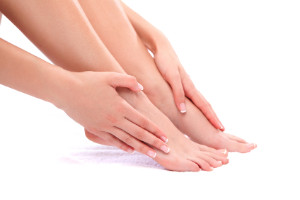
A bump on the bottom of the foot may be indicative of a foot condition known as plantar fibromatosis. This ailment develops on the plantar fascia which is the band of tissue that runs along the bottom of the foot. Its function is to connect the heel to the toes, in addition to supporting the arch. A plantar fibroma can form when nodules grow in the plantar fascia, and can cause pain and discomfort. Research has shown there is no cure for this condition, and existing patients often look to manage the pain. This can be done by performing specific foot stretches that can help to strengthen the foot. A calf stretch is effective in relieving pain from the plantar fascia, and this is done by standing on a step, and lowering the heel until a gentle stretch is felt. Patients may find that performing a marble pick up is helpful in strengthening the arch. This is a simple stretch, and may take some practice to perfect it. This is done by placing several marbles on the floor next to a towel, and picking one marble up at a time with your foot. If you would like more information about how to relieve pain from a plantar fibroma, please consult with a podiatrist.
A plantar fibroma may disrupt your daily activities. If you have any concerns, contact one of our podiatrists of Barry University Foot and Ankle Institute. Our doctors can provide the care you need to keep you pain-free and on your feet.
Plantar Fibroma
A plantar fibroma is a fibrous knot in the arch of the foot. It is embedded in the plantar fascia which is a band of tissue that extends from the heel to the toes along the bottom of the foot. There can be multiple plantar fibromas in the feet at the same time. There are no known causes for this condition. If you have a plantar fibroma, there will be a bump in the arch of your foot that cannot be missed. Any associated pain is most often due to a shoe rubbing against the nodule. Non-surgical options, such as steroid injections, physical therapy, and orthotics should be tried first. Surgery is a last resort and is the only thing that will remove a plantar fibroma entirely. Consult with a podiatrist for a proper diagnosis and to determine the treatment regimen that is right for you.
What Causes a Plantar Fibroma?
While there are no specific causes identified, a plantar fibroma can possibly come from genetic predisposition or the formation of scar tissue that forms from healing the tears in the plantar fascia.
What Are the Symptoms of a Plantar Fibroma?
There will be a noticeable lump in the arch of the foot that may or may not cause pain. If pain is felt, it is typically because a shoe is rubbing up against the lump or when walking or standing barefoot.
Treatment and Prevention
A plantar fibroma will not disappear without treatment, but it can get smaller and be a non-issue. If pain persists, a podiatrist examines the foot and when the arch of the foot is pressed, pain can be felt down to the toes. An MRI or biopsy might be performed to help diagnose or evaluate the plantar fibroma. The following non-surgical options are generally enough to reduce the size and pain of these nodules:
- Steroid injections
- Orthotics
- Physical therapy to help apply anti-inflammatory creams on the bump
Surgery is considered if the mass increases in size and the patient continues to feel pain after non-surgical methods are tried.
If you have any questions please feel free to contact our offices located in Miami, North Miami Beach, Miami Beach, and Tamarac, FL . We offer the newest diagnostic tools and technology to treat your foot and ankle needs.
